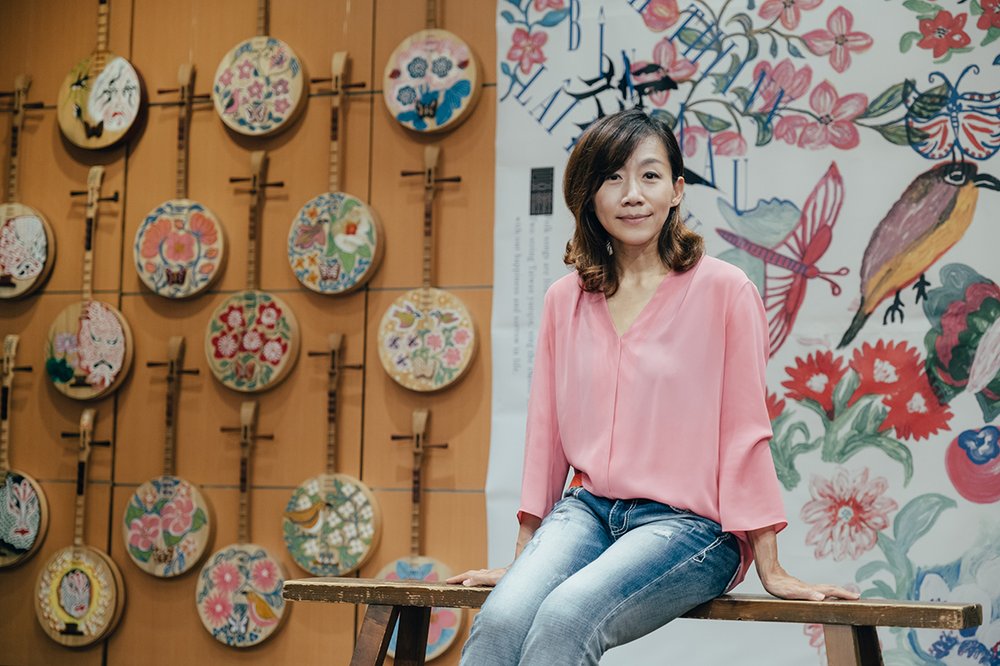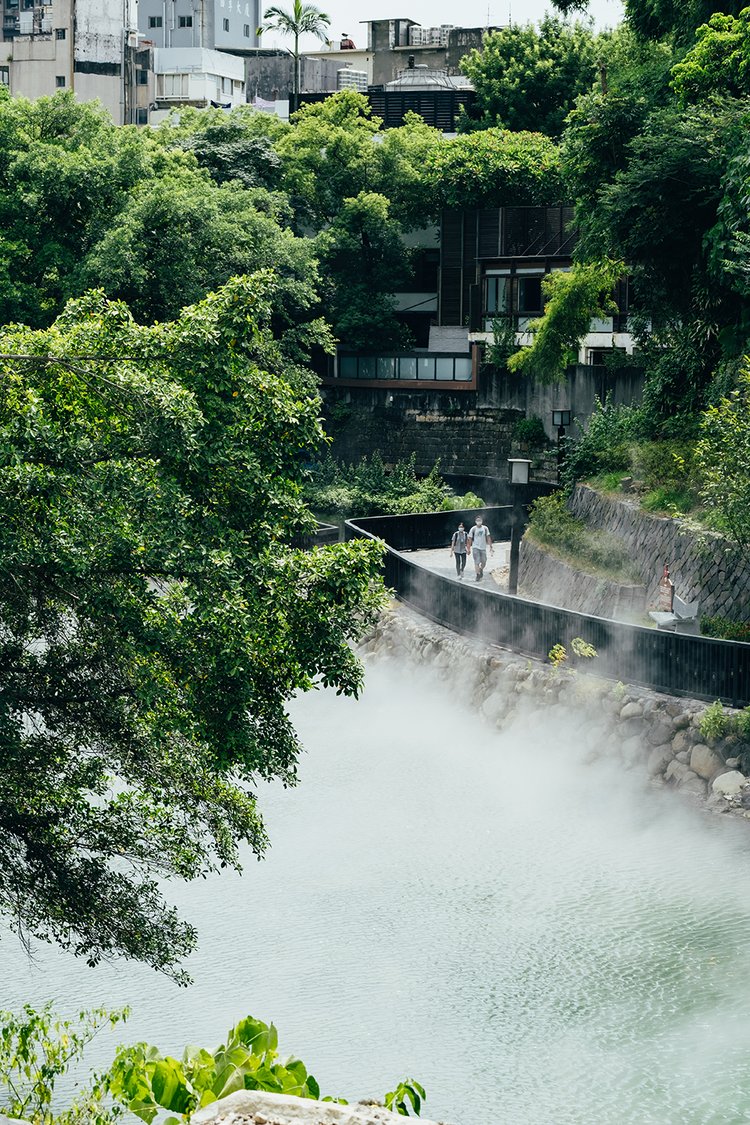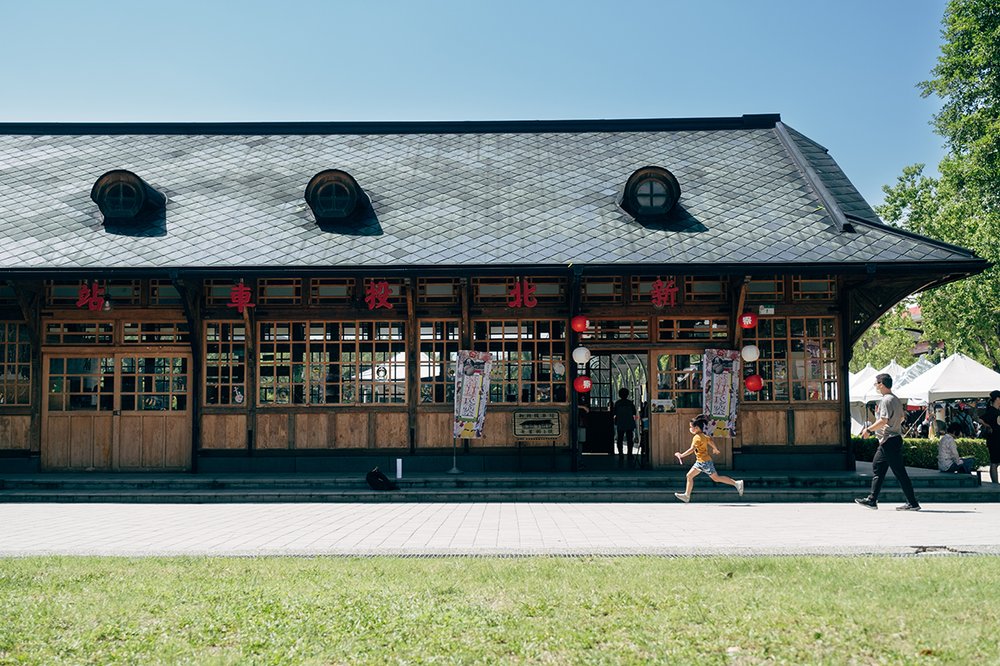Flâneuring the Hot Spring Town
Text - Yu Ju-Ling(游如伶)
Photography - Tsai Yao-Cheng(蔡耀徵)
Writer Hao Yu-Hsiang's Landscape Literature Writing

Photo: Hao Yu-Hsiang, a writer who experienced growing up in Beitou from the late 1970s to the 1980s.
“Beitou, when I was growing up, was far more than just a simple city. It was more of a magical and strange land of hot springs full of imagery.” Hao Yu-Hsiang had this written for the preface to her book “Nether World” (2007). Stating how this book was inspired by her experience growing up in Beitou. The magical atmosphere of the book also extended to her book on her family, writing “The Hot Spring Washes Away Our Sorrow” in 2011. Memories of Beitou for her are like a moveable feast, passing through Hot Spring Lane, Yangmingshan Mountains and even reaching the far away coastal roadways. Finally coming back to the late 1970s and 1980s. Coming back to the hot spring town, which was declining but shows the beauty of the light and shadow.
Life in Beitou: the Growing Experience of being Close to the Mountains and the Sea

Photo: Students waiting for trains on the platform of Beitou Train Station, circa 1987-88. (Photographer: Daigo Chiu〔邱瑞金〕 . Photo courtesy; Huang Li-Feng〔黃麗鳳〕)
In 1975, Hao Yu-Hsiang, in her second year of elementary school, moved with her family from Kaohsiung to Beitou. They settled in Shijian street of Shipai, surrounded by farmland. In the senior year of junior high school, her family moved once again to a new residence behind the Beitou Train Station. Surrounded by barren grasslands, they were among the first to begin residing in the newly built apartment complex; also becoming the residents to live next to the newly opened Daye Road. At that time, for an adolescent girl living in a new and desolate neighborhood, what meant the only way to escape this depressing reality was to take the Tamsui train line that led to the mountains or the seas.
“Because I lived next to the Beitou Train Station. Whenever I wish to travel to Taipei or Tamsui on holidays, I would need to take the Tamsui Line.” Hao Yu-Hsiang said, “When I was in my late teens, I had a longing for escape to a distant place. Symbolically, the railway tracks were a way to such places for me. At the time, we were not heading towards the city, but the seaside. I grew up having the company of the mountains and with the sea.”
In addition to seeking solace from the sea in Danshui’s Shalun, Hao Yu-Hsiang often rode her motorcycle into the maze-like Yangmingshan Mountains during her university life. “The Yangmingshan Mountains were like a mother's embrace. Even being lost on a motorcycle, you wouldn’t be too worried. Contrarily it would make me feel at ease, almost like sleepwalking on an endless mountain road. Lengshuikeng and Qingtiangang were often foggy in the night. The fog would be so thick that we couldn’t see our fingers, while we would be racing each other in the fog.”
“Although Beitou is a part of Taipei, it does not conform to the established impression of Taipei. I would define it as the periphery of the city, a place that is caught between the city and the mountains and the sea.” Hao Yu-Hsiang said, “In those very repressed times, Danshui’s Shalun and Yangmingshan mountains became my places of comfort. The best thing about living in Beitou was that there was always a place one could escape to when you were in a bad mood.”
Tamsui Railway Line (Taipei - Tamsui)
The Tamsui Line was opened for use in 1901, and the Xinbeitou branch line was opened in 1916. After the World War Second, the stations along the Tamsui Line included Taipei, Shuanglian, Yuanshan, Shilin, Shipai, Wangjiamiao, Beitou, Xinbeitou, Zhongyi, Guandu, Zhuwei, and Tamsui. In that period, the Tamsui Line was the main method of transportation for residents. Then the passenger function of the Tamsui Line was gradually replaced by the increasingly developed road transportation network. The entire line was suspended in 1988, and the original line became the foundation of the modern Taipei MRT’s Tamsui-Xinyi Line. The only station preserved on the Tamsui Line is the Xinbeitou Train Station. After the suspension of the rail line, the station was moved to the Taiwan Folk Village in Changhua. After the year 2000, the Taipei City Government, local groups in Beitou, and public historians advocated for its return. The Xinbeitou Historic Station was subsequently moved back to the original site for reconstruction and restoration. The restoration was completed and the station became open to the public in 2017.
Abolition of Prostitution to Scattered Ruins, Beitou’s Magical State in the 1980s

Photo: During Hao Yu-Hsiang’s upbringing, Beitou and its hot spring were at their worst. Even so, she was able to witness the magical and mysterious side of Beitou.
“From the Japanese era, post war and to the present, each generation has seen their own Beitou. During my upbringing, Beitou was at its lowest point. Caused by of the abolition of prostitution, the economy was not as prosperous as it was in its heyday. It was like a place everyone had forgotten. Even so, it still had a unique splendor.”
The year Hao Yu-Hsiang got into university was also the year martial law was lifted, and Taiwan entered a booming era. And Beitou, located on the edge of the Taipei basin, was also getting its own taste of the wildness and recklessness. For example, the Beitou Night Market, which was an eye opener for her, was the Wild West for anyone looking to make a quick buck. It was like a theater put on by snake oil dealers, strippers, Qigong masters. Not far, Dadu road, known for illegal street racing at the time, attracted crowds of thousands, almost like a runway in a fashion, fitting the atmosphere of the streets of Taiwan in the late 1980s.
At the same time, the small hot spring town still had its twists and turns, and had Japanese bars shimmering in the background. During a night’s out, she would also see the motorcycles carrying hostesses in full make up from time to time, disappearing like a puff of smoke on the mountain roads into the night. “At that time there were still a few Japanese-style hot spring hotels hidden in the mountain alleys, only lit by a lamp, often emitting a wet and blurred light. The mother of my college boyfriend was a waitress in ‘Mudan Village’ and would usually take some leftovers for us as a late-night snack, and it became that we often sneaked into the back of the restaurant's kitchen. A light outside the door, and I peeped inside. That is the Beitou Hot Spring in my memory: declining, vicissitudes, old-fashioned, decadent, with some charm and mystique, Beitou was like this and was beautiful. I was witnessing the turning point, what I saw the final face of Beitou’s hostess culture.”
The Rise of Hot Spring Leisure Culture. Witnessing the Transformation of Beitou's Landscape in the 1990s
When Hao Yu-Hsiang was growing up, most of the places for hot springs were small hotels or public bathhouses, a far cry from people's impression of hot spring leisure culture today. “The only experience of bathing in hot springs when I was a child was due to us losing water from a typhoon for five days. Our whole family went to the Beitou bathhouse near the Geothermal Valley to bathe. I didn’t often go to Yangmingshan for hot springs until I was a graduate student. At that time, I lived in Guandu. If I rode my motorcycle to Yangmingshan for night meandering, I would go to the public hot spring in Lengshuikeng or the Manger Hot Spring to bathe.”
Following the 1990s, the Beitou Hot Spring Area was transformed into a tourist destination. The chaotic, secluded, and scattered spaces of old Japanese houses that Hao Yu-Hsiang traversed during her night meandering also disappeared and transformed into a cityscape that had fancy star-rated hotels which was now clean and bright. “People in Taiwan keep erasing the memory of places and rebuilding them according to their own impression of what 'culture’ should be. In the process of modernization, it is often difficult to grasp how local history, memory and emotion should be accounted for.”
On a visit to Japan’s Kusatsu Hot Springs, Hao Yu-Hsiang immediately thought of Beitou after arriving. “Whether it be the planning of parks and city blocks, or the old wooden hot spring hotels, etc. Visually, it was almost the same as the Beitou from memory. When visiting Jigokudani in Japan, it also reminded me of my childhood memories of boiling eggs and sweet potatoes with hot spring water in Geothermal Valley.” She believes that the continuous sense of history in the Japanese landscape preserves her lost experiences and memories of Beitou. That is why the Japanese hot spring areas can evoke her memories and emotions.

Photo: Once known as “Hell Valley”, the New Beitou Geothermal Valley is one of the sources of Beitou's hot springs. Boiling eggs in the steaming waters of the Geothermal Valley is a shared memory of many Beitou residents.
The Tamsui Line, Returning to its Youth in the 2010s

Photo: Xinbeitou Historic Station carries the memories of many local residents.
When writing “The Hot Spring Washes Away Our Sorrow”, Hao Yu-Hsiang also ushered in a new life into this world. The little girl who moved to Beitou as a child was now a mother herself, just when she finished writing about her family. In recent years, she brought her daughter back to Beitou and wanted to identify the things that were once in existence there, but it proved difficult to find a way to connect to her memories. “The landscape of Beitou has changed a lot. What really evokes my memories is the preserved New Beitou Train Station and train carriages. For me, this place is full of emotional significance, so I am very touched”
“The moment I walked with my daughter into the Tamsui Line train carriage on display, I could hardly imagine, this means of transportation I used every day when I was seventeen or eighteen had become part of a museum’s collection. At the same time, the train is still alive and well in my memory.” Hao Yu-Hsiang said, “During urban development and construction, if we could find a way to preserve more local historical memories, maybe more emotional connections could be had.”

Photo: The train that used to run on the Tamsui Line now serves as an exhibition, introducing the history of the train line.
